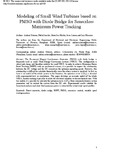Mostrar el registro sencillo del ítem
Modeling of small wind turbines based on PMSG with diode bridge for sensorless maximum power tracking
| dc.creator | Urtasun Erburu, Andoni | es_ES |
| dc.creator | Sanchis Gúrpide, Pablo | es_ES |
| dc.creator | San Martín Biurrun, Idoia | es_ES |
| dc.creator | López Taberna, Jesús | es_ES |
| dc.creator | Marroyo Palomo, Luis | es_ES |
| dc.date.accessioned | 2018-11-08T14:56:17Z | |
| dc.date.available | 2018-11-08T14:56:17Z | |
| dc.date.issued | 2013 | |
| dc.identifier.issn | 0960-1481 (Print) | |
| dc.identifier.issn | 1879-0682 (Electronic) | |
| dc.identifier.uri | https://hdl.handle.net/2454/31325 | |
| dc.description.abstract | The Permanent Magnet Synchronous Generator (PMSG) with diode bridge is frequently used in small Wind Energy Conversion Systems (WECS). This configuration is robust and cheap, and therefore suitable for small WECS. In order to achieve Maximum Power Point Tracking (MPPT) with no mechanical sensors, it is possible to impose the relationship between the DC voltage and the DC current on the optimum operating points. However, this relationship is difficult to calculate theoretically since the whole system is involved. In fact, as there is no model of the whole system in the literature, the optimum curve IL*(Vdc) is obtained with experimental tests or simulations. This paper develops an accurate model of the whole WECS, thereby making it possible to relate the electrical variables to the mechanical ones. With this model, it is possible to calculate the optimum curve IL*(Vdc) from commonly-known system parameters and to control the system from the DC side. Experimental results validate the theoretical analysis and show that maximum power is extracted for actual wind speed profiles. | en |
| dc.description.sponsorship | This work was partially funded by the Spanish Ministry of Economy and Competitiveness under Grants DPI2009-14713-C03- 01 and DPI2010-21671-C02-01, by the Government of Navarra and the FEDER funds under project “Microgrids in Navarra: design and implementation” and by the Public University of Navarra. | en |
| dc.format.mimetype | application/pdf | en |
| dc.language.iso | eng | en |
| dc.publisher | Elsevier | en |
| dc.relation.ispartof | Renewable Energy 55 (2013) 138-149 | en |
| dc.rights | © 2013 Elsevier Ltd. The manuscript version is made available under the CC BY-NC-ND 4.0 license. | en |
| dc.rights.uri | https://creativecommons.org/licenses/by-nc-nd/4.0/ | |
| dc.subject | Boost converter | en |
| dc.subject | Diode bridge | en |
| dc.subject | MPPT | en |
| dc.subject | PMSG | en |
| dc.subject | Sensorless control | en |
| dc.subject | Variable speed wind generation | en |
| dc.title | Modeling of small wind turbines based on PMSG with diode bridge for sensorless maximum power tracking | en |
| dc.type | Artículo / Artikulua | es |
| dc.type | info:eu-repo/semantics/article | en |
| dc.contributor.department | Ingeniería Eléctrica y Electrónica | es_ES |
| dc.contributor.department | Ingeniaritza Elektrikoa eta Elektronikoa | eu |
| dc.rights.accessRights | Acceso abierto / Sarbide irekia | es |
| dc.rights.accessRights | info:eu-repo/semantics/openAccess | en |
| dc.identifier.doi | 10.1016/j.renene.2012.12.035 | |
| dc.relation.publisherversion | http://dx.doi.org/10.1016/j.renene.2012.12.035 | |
| dc.type.version | Versión aceptada / Onetsi den bertsioa | es |
| dc.type.version | info:eu-repo/semantics/acceptedVersion | en |
| dc.contributor.funder | Universidad Pública de Navarra / Nafarroako Unibertsitate Publikoa | es |



